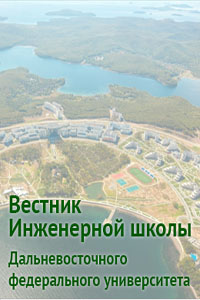Prediction of a ship’s principal dimensions at the preliminary design stage using an artificial neural network
DOI:
https://doi.org/10.24866/2227-6858/2025-3/55-68Keywords:
artificial neural networks, mean absolute percentage error, preliminary design, input layer, output layerAbstract
This study investigates the application of artificial neural networks (ANNs) in ship design. Unlike empirical formulas and statistical methods, ANNs provide a flexible and efficient alternative, demonstrating their ability to accurately model complex systems. The objective of this research is to develop an ANN model for predicting the principal dimensions of fishing vessels at the preliminary design stage. The input layer included the vessel’s displacement and service speed, while the output layer comprised the main hull dimensions – length overall, breadth, draft, and depth. Using a dataset of 590 fishing vessels, excluding sister ships, the developed ANN model demonstrated promising results with minimal errors. Performance metrics such as the Mean Absolute Percentage Error (MAPE) and correlation coefficients highlight the adequacy of the model and its high predictive accuracy for the principal dimensions (length L, breadth B, draft T, and depth D).
References
1. Эванс Дж.Х. Основные концепции проектирования // Journal of the American Society of Naval Engineers. 1959. Т. 71, № 4. С. 671–678. (англ.). https://doi.org/10.1111/j.1559-3584.1959.tb01836.x
2. Папаниколау А. Методология предварительного проектирования судов. Dordrecht: Springer, 2014. 625 с. (англ.). https://doi.org/10.1007/978-94-017-8751-2
3. Клаусен Х.Б., Лютцен М., Фрис-Хансен А., Бьёрнебу Н.К. Байесовские и нейронные сети для предварительного проектирования судов // Marine Technology. 2001. Т. 38, № 4. С. 268–277. (англ.). https://doi.org/10.1016/B978-008043950-1/50044-2
4. Алкан А., Гюлез К., Йылмаз Х. Проектирование надёжной архитектуры нейронной сети для определения параметров начальной остойчивости рыболовных судов // Ocean Engineering. 2004. Т. 31, № 6–7. С. 761–777. (англ.). https://doi.org/10.1016/j.oceaneng.2003.08.002
5. Матуйя Д., Деалла Р., Барбир О. Применение искусственной нейронной сети для выбора максимально эффективного гребного винта судна // Journal of Ship Production and Design. 2010. Т. 26, № 3. С. 199–205. (англ.).
6. Ким С., Мун Б., Ким Д. Оптимальное проектирование системы проектирования судна с использованием метода нейронных сетей на этапе начального проектирования обшивки корпуса // KSME International Journal. 2004. Т. 18, № 11. С. 1923–1931. (англ.).
7. Цуй Ю., Туран О., Сайер П. Оптимизация проектирования судов с помощью алгоритмов машинного обучения // Computer-Aided Design. 2012. Т. 44, № 3. С. 186–195. (англ.). https://doi.org/10.1038/nature14539
8. ЛеКан Й., Бенджио Й., Хинтон Г. Глубокое обучение // Nature. 2015. Т. 521, № 7553. С. 436–444. (англ.). https://doi.org/10.1038/nature14539
9. Гудфеллоу И., Бенджио Й., Курвилл А. Глубокое обучение. Cambridge (MA): MIT Press, 2016. 800 p. (англ.).
10. Шмидхубер Й. Глубокое обучение в нейронных сетях // Neural Networks. 2015. Т. 61. С. 85–117. (англ.). https://doi.org/10.1016/j.neunet.2014.09.003
11. Хейкин С. Нейронные сети и методы машинного обучения. Upper Saddle River: Prentice Hall, 2009. 906 p. (англ.).
12. Хорник К., Стинчкомб М., Уайт Х. Многослойные сети – универсальные аппроксиматоры // Neural Networks. 1989. Т. 2, № 5. С. 359–366. (англ.). https://doi.org/10.1016/0893-6080(89)90020-8
13. Чжан Ц., Уоллес Б. Анализ чувствительности свёрточных нейронных сетей для классификации предложений // Proceedings of the 8th International Joint Conference on Natural Language Processing (IJCNLP‑2017). 2017. С. 253–263. (англ.). https://aclanthology.org/I17-1026.pdf
14. Вербос П.Дж. Обратное распространение во времени: что это такое и как это делать // Proceedings of the IEEE. 1990. Т. 78, № 10. С. 1550–1560. (англ.). https://ieeexplore.ieee.org/document/58337
15. Шоле Ф. Глубокое обучение на Python. Manning, 2018. 384 p. (англ.).
16. Гэвин Х.П. Алгоритм Левенберга – Марквардта для нелинейных задач наименьших квадратов. Durham: Duke University, 2024. 23 с. (англ.). https://people.duke.edu/~hpgavin/lm.pdf
17. Мёллер М.Ф. Масштабированный метод сопряжённых градиентов для быстрого обучения // Neural Networks. 1993. Т. 6, № 4. С. 525–533. (англ.).
18. Аджитеш К. Алгоритм backpropagation в нейронных сетях // Analytics Yogi. 2023. Т. 1, № 1. С. 1–10. (англ.). https://vitalflux.com/neural-network-back-propagation-python-examples/
Downloads
Published
Issue
Section
License
Copyright (c) 2025 Far Eastern Federal University: School of Engineering Bulletin

This work is licensed under a Creative Commons Attribution 4.0 International License.

